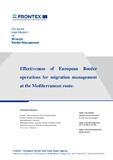| dc.contributor.author | Pentimalli, Leandro Cesare | |
| dc.contributor.other | Yordanov Ferdov, Stavri, First Supervisor | |
| dc.contributor.other | Bileišis, Mantas, Second Supervisor | |
| dc.contributor.other | Frontex – European Border and Coast Guard Agency | |
| dc.date.accessioned | 2020-04-16T18:48:40Z | |
| dc.date.available | 2020-04-16T18:48:40Z | |
| dc.date.issued | 2019 | |
| dc.identifier.uri | https://digiriiul.sisekaitse.ee123456789/2457 | |
| dc.description | Introduction ; 1.1. Background information ; 1.2. Statement of the problem ; 1.3. Research Goal ; 1.4. Research objectives ; 1.5. Significance of the study ; 1.6. Limitations of the study ; 1.7. Assumptions of the study ; Literature review ; 2.1. Efficiency versus effectiveness of the EU border management ; 2.2. The complexity of EU border management ; 2.3. EU border management crisis ; 2.3.1. Situation along the Mediterranean migration routes ; 2.3.1.1. Central Mediterranean Route ; 2.3.1.2. East Mediterranean Route ; 2.3.1.3. West Mediterranean Route ; 2.4. EU Support to Border Migration Crisis ; 2.4.1. European Border and Coast Guard Agency (Frontex) ; 2.4.2. Operations ; 2.4.2.1. Operation Sophia ; 2.4.2.2. Operation Poseidon (Greece) ; 2.4.2.3. Operation Indalo (Spain) ; 2.4.2.4. Operation Themis ‘formerly Triton’ (Italy) ; 2.5. Effectiveness of EBCGA Operations ; Research methodology ; 3.1. Introduction ; 3.2. Appropriateness of the Research Design ; 3.3. Research design ; 3.4. Pilot study ; 3.5. Settings and participants ; 3.6. Instrumentation ; 3.7. Data Collection Methods ; 3.7.1. Interview process ; 3.8. Data analysis ; 3.9. Ethical considerations ; 3.10. Limitations of the Research ; 3.11. Conclusion ; Findings, interpratations and discussion ; 4.1. Introduction ; 4.2. Results Analysis ; 4.2.1. Migration Crisis in EU and the contributing factors ; 4.2.1.1. Europe’s geographical positioning ; 4.2.1.2. Scarcity of natural resources ; 4.2.1.3. Political and social instability ; 4.2.2. Consequences of the migration crisis ; 4.2.3. Role of EU Commission and Agencies in Mitigation of the Migration Crisis ; 4.2.3.1. How Joint Operations are put together ; 4.2.4. Perceptions of the impact of Joint Operations in Maintaining Border Security ; 4.2.4.1. Varying policy adaptations ; 4.2.4.2. Bureaucracy ; 4.2.4.3. Role confusion ; 4.2.4.4. Lack of accountability ; 4.3. Data interpretation ; 4.3.1. Enhancing the Efficiency of the EU Border Management ; 4.4. Conclusion ; Recommendations and conclusions ; 5.1. Introduction ; 5.2. Recommendations for increasing the efficiency of Joint Operations involved in the management of the EU external borders ; 5.2.1. Manage the problem from the root ; 5.2.2. Improving policy design ; 5.2.3. Improving competency ; 5.2.4. Resource availability ; 5.2.5. Increasing surveillance ; 5.2.6. Increasing cooperation between agencies ; 5.3. Conclusion | et_EE |
| dc.description.abstract | Border control in the Mediterranean route is yet to attain complete success since the number of incoming migrants is overwhelming the efforts taken by the border control agencies. As such questions have been raised on how Joint Operations can improve to ensure that goals are met efficiently. Consequently, this research carried out an investigation into the perceptions of agency operators, to determine the current state at the ground and deduce recommendations that would help improve the situation. Therefore, experts from the national level were interviewed to establish truth from the data retrieved from the empirical review of literature. | et_EE |
| dc.language.iso | en_US | et_EE |
| dc.publisher | Frontex | et_EE |
| dc.subject | piirikontroll | et_EE |
| dc.subject | piirid (territ.) | et_EE |
| dc.subject | rändepoliitika | et_EE |
| dc.subject | ränne (demogr.) | et_EE |
| dc.subject | Euroopa Liit | et_EE |
| dc.subject | migration policy | |
| dc.subject | migration | |
| dc.subject | borders | |
| dc.subject | border control | |
| dc.title | Effectiveness of European Border operations for migration management at the Mediterranean route | et_EE |
| dc.type | Thesis | et_EE |



